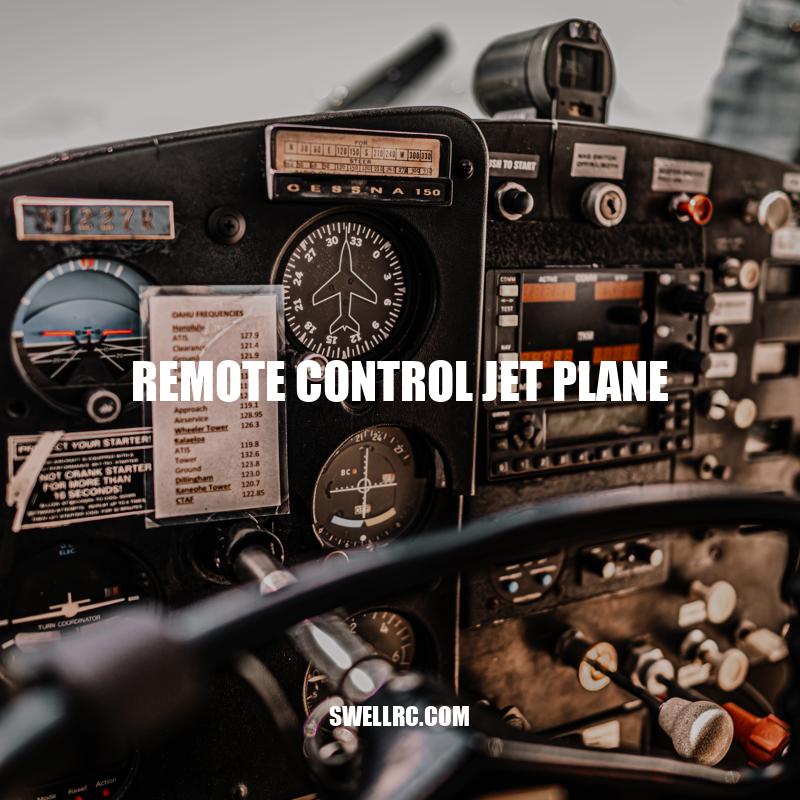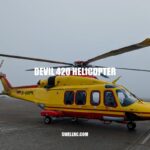Remote Control Jet Planes: A Beginner’s Guide to Safety, Types and Maintenance
Remote control jet planes are a fascinating hobby that has captured the attention of aviation enthusiasts worldwide. These miniature aircraft are modeled after real-life jets and are designed to be flown from the ground using a handheld remote control. The pilot on the ground controls the jet’s movements by sending a signal to the onboard receiver that controls the motors and other functions. Remote control jet planes come in various sizes and styles, ranging from small electric models to larger-scale gas or jet turbine-powered planes capable of reaching high speeds and altitudes.
One of the most significant advantages of remote control jet planes is that they allow pilots to experience the thrill of flying without the risk or expense of piloting a full-scale airplane. Unlike traditional model planes, remote control jet planes offer a realistic and thrilling flight experience that feels like flying a real jet. These aircraft allow pilots to test their flying skills and experiment with different maneuvers and techniques, making them a favorite among aviation enthusiasts of all ages.
In addition to being an exciting hobby, remote control jet planes are also used for other purposes, such as scientific research, military training, and commercial filming. They offer a cost-effective and safe way of gathering data, training pilots, and capturing aerial footage without having to put human pilots in harm’s way. For hobbyists, remote control jet planes provide a challenging and rewarding pastime that allows them to explore the limits of flight and share their passion with others.
Overall, remote control jet plane hobbyists can enjoy a fulfilling experience that combines excitement, skill-building, and camaraderie. Whether they are flying for fun or pursuing more serious goals, these miniature aircraft offer endless possibilities for creativity, learning, and entertainment. Despite the challenges and risks of flying, remote control jet planes remain an enduring and fascinating pastime that will continue to inspire and thrill people for years to come.
Remote control jet planes are available in various sizes and types, each with distinct features that cater to specific pilot preferences, skills, and budgets. Some of the most common types of remote control jet planes include:
- Electric-powered planes
- Jet turbine engine planes
- Gas-powered planes
Electric-powered planes are an excellent choice for beginners or those new to remote control flying. They are typically smaller, slower, and less powerful than other types of planes and are powered by rechargeable batteries. Jet turbine engine planes, on the other hand, are the fastest and most powerful of all remote control jet planes. They use miniature engines that run on kerosene or other fuels and can fly at high speeds and altitudes. Gas-powered planes are another popular option, known for their longer flight times and excellent endurance.
Regardless of the type of remote control jet plane that you choose, there are several essential features that you should consider to ensure that you get the best performance and experience possible. Some of these features include:
- Wing design – Determines stability and maneuverability
- Fuselage material – Impact resistance and overall durability
- Motor type and power – Speed, thrust, and performance capacity of the engine
- Control system – The type and quality of the radio transmitter and receiver
- Size and weight – Compatibility with the pilot’s skill level and flying conditions
Several online retailers sell remote control jet planes, such as Horizon Hobby, Target, and Amazon. These websites offer a wide range of models, accessories, and offer customer service to respond to potential issues and assist with maintenance.
What is a good remote control plane?
A good remote control plane is one that meets your needs and skill level. Here are some things to consider:
- Type: Will you be flying indoors or outdoors? Do you want a plane for acrobatics or just leisurely flying?
- Size: How much space do you have to fly? A larger plane might require a bigger area to maneuver.
- Power source: Do you want a gas-powered or electric-powered plane?
- Price: Remote control planes can range from $50 to several hundred dollars.
Some popular remote control plane brands include:
- HobbyZone
- ParkZone
- E-flite
- Blade
If you’re looking to purchase a remote control plane, online retailers such as Amazon and Horizon Hobby offer a variety of options and reviews from other users.
Remote control jet planes are fascinating and dynamic machines that have a rich history and a bright future. Here are some interesting facts about remote control jet planes:
- Remote control jet planes were invented in the 1930s in response to the growing interest in aviation and the advancement of radio technology.
- Today’s remote control jet planes can reach speeds of over 200 miles per hour and fly to altitudes exceeding 30,000 feet.
- Remote control jet planes are used by the military for training purposes, such as for the training of fighter pilots and for drone surveillance.
- The largest remote control jet plane in the world is a 1/2 scale model of a Boeing 777 airplane, which has a wingspan of 31 feet and weighs over 700 pounds.
If you are looking to get started with remote control jet planes, there are several resources available online to help you learn and get started. Some websites offer helpful guides on flying techniques, maintenance, and purchasing, such as RC Groups and RC Universe. Additionally, there are several online forums and communities dedicated to remote control jet planes, where pilots can share tips, experiences, and insights into the latest technology and trends.
Here is a table comparing the three most common types of remote control jet planes: electric-powered, jet turbine engine, and gas-powered planes.
| Feature | Electric-Powered Planes | Jet Turbine Engine Planes | Gas-Powered Planes |
| Power | Less powerful, but good for beginners | Most powerful, but expensive and complex to operate | Moderately powerful, known for long flight times |
| Speed | Slower than other types of planes | Fastest of all remote control planes | Faster than electric-powered planes but slower than jet turbine engines |
| Cost | Less expensive than other types of planes | Most expensive of all remote control planes | Moderately priced |
| Maintenance | Low maintenance required | High maintenance required | Moderate maintenance required |
What are some cool facts about jet planes?
Some cool facts about jet planes are:
- A typical commercial jet engine can produce a thrust of up to 100,000 pounds
- The world’s fastest jet plane, the Lockheed SR-71 Blackbird, can reach speeds of up to Mach 3.3 (2,193 mph)
- The Airbus A380, the world’s largest passenger jet, has a wingspan of 80 meters
- The Boeing 747, also known as the “Jumbo Jet”, has two decks and can carry up to 660 passengers
- The supersonic passenger jet Concorde had a maximum speed of Mach 2.04 (1,354 mph)
Check out websites such as National Geographic or Discovery Channel for more interesting facts and information about jet planes. You can also find cool products related to aviation on websites such as Amazon or Etsy.
Tips for Safe Operation of Remote Control Jet Planes
While remote control jet planes can be a lot of fun, it’s important to remember that they can pose a potential safety hazard if not operated correctly. Here are some tips to help you operate your remote control jet plane safely:
- Always fly in designated areas and avoid flying near populated areas, airports, or other restricted airspace.
- Before each flight, check to make sure that the airplane and all equipment are in good working condition. Any damage or malfunction should be addressed immediately.
- Ensure that your plane’s batteries are fully charged, and bring along plenty of extra batteries to avoid running out of power during your flight.
- Always fly with a skilled, experienced operator, especially when you’re just getting started. It’s also helpful to have another person act as a spotter to help you keep track of your plane while in flight.
- Practice safe flying techniques, such as avoiding flying too high or too far away, and avoiding flying directly over people or obstacles that could cause a collision.
There are a few essential items to consider when purchasing remote control jet planes for safe operation.
- A good-quality radio transmitter is essential for controlling the airplane from the ground.
- Batteries and battery chargers are necessary for extended flight times.
- Aircraft stands, tools, and spare parts are recommended for maintenance and repair purposes.
- Online stores like Horizon Hobby and Motion RC offer a wide range of remote control jet planes and related equipment.
How do you fly a remote control plane?
Flying a remote control plane can be a fun and exciting activity. Here are some basic steps to fly a remote control plane:
1. Choose a suitable location with enough space to fly your plane, away from people and obstacles.
2. Make sure your plane is fully charged and perform an initial check to ensure everything is in working order.
3. Position yourself in an open area and stand at a safe distance from the plane.
4. Gradually increase the throttle and let the plane take off.
5. Steer the plane using the controller’s joystick and make adjustments as needed.
6. Practice landing the plane gently back on the ground.
It’s important to read the instructions manual that comes with your remote control plane to understand any specific instructions or safety precautions. You can also visit websites such as rcpowers.com or hobbyking.com to purchase a remote control plane, accessories or get additional tips on how to fly your plane.
Purchasing and Maintenance of Remote Control Jet Planes
When purchasing a remote control jet plane, there are several factors to consider, such as your experience level, budget, and desired performance capabilities. Here are some tips to help guide your decision:
- Consider your experience level when choosing a remote control jet plane. Beginners should start with slower, more stable planes, while experienced operators can try faster, more maneuverable planes.
- Pay attention to the construction and materials used in the plane’s design. High-quality materials like balsa wood or composite materials can make for a more durable, long-lasting plane.
- Price is an important consideration, but don’t be tempted to skimp on quality in exchange for a lower price tag. Investing in a high-quality plane will save you money in the long run by minimizing the need for repairs or replacements.
- Check online forums and reviews to see what other operators are saying about different planes. This can help you narrow down your options and choose the best plane for your needs.
Maintenance is also an important consideration to prolong the life and performance of your airplane. Here are some general tips for maintaining your remote control jet plane:
- Regularly clean your plane after each flight to remove dirt, dust, and debris that can damage the airplane’s components.
- Check for any damage or malfunctions before and after each flight, and address any issues before flying again.
- Apply a protective coating to the plane’s exterior to prevent damage from UV rays and moisture.
- Store your airplane in a dry, cool place to prevent damage from heat or humidity.
Some online stores offer a wide range of remote control jet planes and related equipment, including radio transmitters, batteries, chargers, and spare parts. Popular sites for purchasing remote control jet planes include Horizon Hobby and Motion RC, which offer a wide variety of planes and equipment for operators of all skill levels.
What are the components of a remote control plane?
The components of a remote control plane typically include:
- Transmitter
- Receiver
- Electronic speed controller (ESC)
- Battery
- Servo
- Motors/engines
- Propellers
- Airframe/body of the plane
These components work together to control the movements of the plane in flight. The transmitter sends signals to the receiver, which then relays those signals to the ESC and servo to control the motor(s) speed and plane direction. The battery provides power to the ESC and motors/engines.
For more information on remote control planes and their components, check out websites such as Horizon Hobby or Tower Hobbies. These sites offer a variety of products and resources for both beginner and advanced remote control plane enthusiasts.
Conclusion
In conclusion, remote control jet planes are a thrilling and exciting hobby that brings together the worlds of aviation and technology. While these planes can be complex and require some knowledge and practice to operate, they offer a wide range of benefits and opportunities for enthusiasts of all ages to learn and grow.
Whether you’re looking to explore scientific research, military training, or simply enjoy the thrill of flying, remote control jet planes offer a unique perspective on the world of aviation. With proper care, regular maintenance, and responsible operation, these planes can last for years and provide countless hours of enjoyment.
If you’re interested in getting started with remote control jet planes, be sure to do your research, purchase high-quality equipment, and follow safety guidelines at all times. By taking the necessary precautions and investing in quality equipment, you can enjoy the many benefits of this exciting hobby for years to come.



